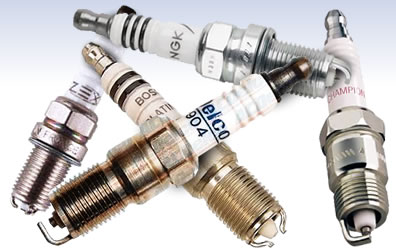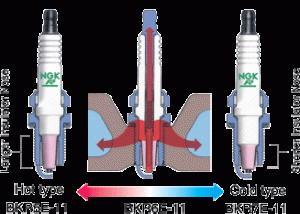The spark plug is the Rodney Dangerfield of the hot rodding universe. It gets no respect—or at least very little. As performance enthusiasts, we tend to focus on power builders like high-flow cylinder heads, big camshafts, and mandrel-bent exhaust components. Fact is you can throw thousands of dollars worth of speed parts at your engine, but those oft-overlooked spark plugs still hold the key to making your powerplant go.
Fortunately, choosing the proper spark plugs for the average daily-driven vehicle is easy. Simply tell your auto parts sales rep your vehicle make and model, and they can look up the proper replacement spark plug based on the manufacturer’s recommendations. However, if you’ve modified your engine, finding just the right spark plugs is a little more involved.
Depending on your engine modifications, you’ll need to take a few extra factors into consideration before settling on the right spark plugs. These factors include spark plug seat design, thread length and diameter, and reach. We’ll cover these elements more in depth later on, but for now, we’ll shed some light on one of the most important—and most misunderstood—factors in choosing aftermarket spark plugs: heat range.
What is Heat Range?
Heat range is the speed at which a spark plug can transfer heat from the firing tip to the cylinder head water jacket and into the cooling system. Choosing the right heat range is crucial for high performance engines. If the heat range is too cold, the spark plug will be unable to properly self-clean by burning off carbon deposits. If it the heat range is too hot, your engine could experience detonation, pre-ignition, or power loss. Most spark plug manufacturers recommend that the tip temperature remain between 500-850 degrees Celsius.
Heat ranges are designated by each spark plug manufacturer with a number. In broad terms, spark plugs are often referred to as “hot plugs” or “cold plugs.” A cold plug has a shorter insulator nose length—the distance from tip to spark plug shell—and transfers heat rapidly from its firing tip to the cylinder head water jacket. Cold plugs are ideal for high rpm engines, forced induction applications, and other instances where the engine produces high operating temperatures. Conversely, hot plugs are good for applications that operate mainly at low rpms. Because they have a longer insulator nose length, heat is transferred from the firing tip to the cooling system at slower pace. This keeps the spark plug temperature high, which allows the plug to self clean and prevent fouling.
Unfortunately, heat range numbers are not universal—each brand has its own method for assigning heat ranges. You’ll need to talk with your sales rep or consult with the manufacturer to find the best heat range for your application and spark plug brand. Be prepared to supply some basic vehicle information, including any modifications you’ve made. As a rule of thumb, you can expect to require one heat range colder than the factory-supplied plugs for every 75-100 horsepower you’ve added with your modifications, according to Champion Spark Plugs. Here are some more basic guidelines to get you pointed in the right direction:
Basic Heat Range Guidelines
- Supercharging/turbocharging: Forced induction leads to increased cylinder pressure and temperature, which could lead to detonation. Depending on the exact application, you’ll need to go with a significantly colder heat range (faster heat transfer) over stock.
- Nitrous oxide: The high cylinder temperatures caused by nitrous usually requires a colder heat range over the stock plug.
- Methanol: Since it has a higher octane level than standard gasoline, methanol delivers more complete combustion. As a result, you’ll need a colder plug to transfer more heat from the combustion chamber.
- Increased compression ratio: Higher compression ratios mean higher cylinder pressure and temperature. Once again, you’ll need a colder heat range to rapidly transfer all that extra heat to the cooling system.
- Air/fuel mixture modifications: Lean air/fuel mixtures raise the operating temperature, along with the plug tip temperature, possibly causing knock or pre-ignition. Use a colder heat range for leaner air/fuel mixtures. Rich air/fuel mixtures can cause the plug temperature to dip, allowing carbon deposits to build up on the tip. Use a hotter heat range for rich air/fuel mixtures.
- Advanced ignition timing: In general, advanced ignition timing will raise the spark plug temperature. In fact, NGK estimates an increase of 70-100 degrees for every 10 degrees of advance in ignition timing. For this reason, you may need to go with a colder heat range to prevent knock or pre-ignition.
- Prolonged acceleration/high speed driving: Frequent and drawn-out acceleration and high-rpm driving raises combustion temperatures and generally requires a colder heat range.
Armed with the right information, you can zero in on the spark plug right heat range for your application.



good info it what Ive been doing for years.
Hello beautiful Mk IV. I am building a MK IV as well. I am getting closer and closer to paint. I thought I had my color picked until I saw the Summit MK IV. Can you tell me what color combination you have on the MK IV?
Hi Samson. Factory Five used Summit Racing 2-Stage Paint: Killer Gray Metallic (SUM-SWBC522-12) and Viper Red (SUM-SWBC502-12). Hope this helps!
[…] Possible Causes: Depending on whether the spark plug is coated in oil or fuel, wet fouling can be symptomatic of a compromised head gasket, poor control from your pistons’ oil control ring, valvetrain problems, or an extremely rich condition. Dry fouling, or carbon fouling, is often caused by an overly rich condition, and the problem may lie with your air cleaner (clogged) or carburetor. Other possible causes could be low compression, vacuum leak, overly retarded timing, or improper spark plug heat range. […]
[…] about a rich condition. Running on the rich side can be caused by a spark plug with too hot a heat range, carburetor float level set too high, and dozens of other things. I think you have a carburetor […]
Have a 496 that is 10:1. It has throttle body injection. (Fitech). What heat range do u think is the right one??
I too have a 496 with FiTech (MeanStreet) and while I have a Mathematical combustion ratio of 10.3:1, I started with the plugs recommended by the manufacturer of the cyl heads (Brodix).
You should look at the plugs you are currently using to see how they are coloring then based on that and any signs of detonation make a decision to go up or down in heat range.
Don’t make the mistake of pulling into the garage and idling a while then pulling the plugs because that will skew the color. Go climb a grade then pull over and pull a plug to see how they look. Do a hard acceleration through the gears and do the same thing.
Of course keep in mind how the motor will see most of its miles. Don’t chose plugs based on the 1/4 mile if your going to be doing most mileage cruising…. buy a second set of plugs for the drags.
Cheers
Autolite offers free heat range advice though its hotline on the webpage
Agreed! That’s why I use them. They have the easiest choice of heat range offerings, clearly defined. Many other spark plug companies act like it’s a military secret which of their plugs are hotter or colder.
Hi,
I’m running a Chev 355, small B&M supercharger producing about 9.5 lbs boost. Approximately 8.2:1 compressio(calculated). Dart 2 cast iron 72cc heads. FI Tech power added fuel injection. Get the odd run on when turning off and 3 to 4 seconds before cartons over.
Using stock AC Delco plugs.
Am I using the correct plug?
That run on is a combination of things.
An ignition source (likely the hot plug) and a fuel/air charge being left after the EFI shuuts off.
You can try a different plug although make sure you idle AFR is not overly rich ot that your IAC is as low as reasonably possible.
[…] has a copper core that controls the heat range. This is important for […]
Have Accel 576S Spark plug, need hotter range. Could you give me the plug number for a hotter plug?
Hey Dave, from what we can tell, Accel’s assigned that particular plug a “6” on their heat range scale. According to Accel’s chart found here, the next hottest is a 7, which is also what they consider their “hottest” plug.
We found these two with a “7” heat range and a 14mm thread pitch, but they both have a shorter 0.375″ reach than your 0576S plug’s 0.460″ reach.
***
But! Going by that same Accel chart we linked to above, an Accel “7” is equal to a NGK “4”. So…
***
Here are some NGK “4” plugs with a 14mm thread/0.460″ reach.
***
Hope this helps!
vac advance it the mechanical tool they would use
to keep the plug tips at near ideal temps .
my old fe ford would call zero at idle
( autolite 4100) four corner idle .
but raise the idle up 50 rpm or so and i get a broader/ fatter advance. till about 1200 ish revs.
this heats up the plug tip to clean it.
once at 3/4 throttle or wide open the fat curve drops away it’s not needed. at idle they still coat
with this trash we call gasoline . as it should.